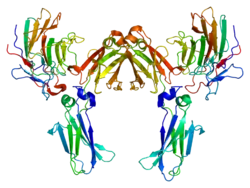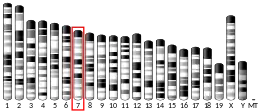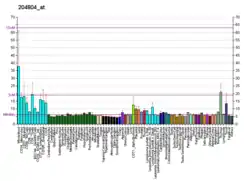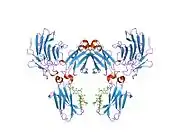Tripartite motif-containing protein 21, also known as E3 ubiquitin-protein ligase TRIM21, is a protein that in humans is encoded by the TRIM21 gene.[5][6] Alternatively spliced transcript variants for this gene have been described but the full-length nature of only one has been determined. It is expressed in most human tissues.[7]
Structure
TRIM21 is a member of the tripartite motif (TRIM) family. The TRIM motif includes three zinc-binding domains, a RING finger domain, a B-box type 1 and a B-box type 2 zinc finger, and a coiled coil region.[6]
Function
TRIM21 is an intracellular antibody effector in the intracellular antibody-mediated proteolysis pathway. It recognizes Fc domain[8] and binds to immunoglobulin G, immunoglobulin A[9] and immunoglobulin M on antibody marked non-enveloped virions which have infected the cell. Either by autoubiquitination or by ubiquitination of a cofactor, it is then responsible for directing the virions to the proteasome. TRIM21 itself is not degraded in the proteasome unlike both the viral capsid and the bound antibody.[7]
TRIM21 is part of the RoSSA ribonucleoprotein, which includes a single polypeptide and one of four small RNA molecules. The RoSSA particle localizes to both the cytoplasm and the nucleus.[6]
Clinical significance
RoSSA interacts with autoantigens in patients with Sjögren's syndrome and systemic lupus erythematosus.[6] In addition, the inability for lupus-prone macrophages to degrade immune complexes in the lysosome results in the leakage of autoantibodies into the cytosol that can bind to TRIM21 and enhance NF-κB signaling.[10]
TRIM21 can be used to knockout specific proteins with their corresponding antibodies, a method known as Trim-Away. In this assay, TRIM21 and antibodies are delivered into cells through electroporation, and the targeted protein is degraded within a few minutes.[11]
References
- 1 2 3 GRCh38: Ensembl release 89: ENSG00000132109 - Ensembl, May 2017
- 1 2 3 GRCm38: Ensembl release 89: ENSMUSG00000030966 - Ensembl, May 2017
- ↑ "Human PubMed Reference:". National Center for Biotechnology Information, U.S. National Library of Medicine.
- ↑ "Mouse PubMed Reference:". National Center for Biotechnology Information, U.S. National Library of Medicine.
- ↑ Frank MB, Itoh K, Fujisaku A, Pontarotti P, Mattei MG, Neas BR (January 1993). "The mapping of the human 52-kD Ro/SSA autoantigen gene to human chromosome 11, and its polymorphisms". American Journal of Human Genetics. 52 (1): 183–91. PMC 1682114. PMID 8094596.
- 1 2 3 4 "Entrez Gene: TRIM21 tripartite motif-containing 21".
- 1 2 Mallery DL, McEwan WA, Bidgood SR, Towers GJ, Johnson CM, James LC (November 2010). "Antibodies mediate intracellular immunity through tripartite motif-containing 21 (TRIM21)". Proceedings of the National Academy of Sciences of the United States of America. 107 (46): 19985–90. Bibcode:2010PNAS..10719985M. doi:10.1073/pnas.1014074107. PMC 2993423. PMID 21045130.
- ↑ James LC, Keeble AH, Khan Z, Rhodes DA, Trowsdale J (April 2007). "Structural basis for PRYSPRY-mediated tripartite motif (TRIM) protein function". Proceedings of the National Academy of Sciences of the United States of America. 104 (15): 6200–5. Bibcode:2007PNAS..104.6200J. doi:10.1073/pnas.0609174104. PMC 1851072. PMID 17400754.
- ↑ Bidgood, Susanna; Tam, Jerry; McEwan, William; Mallery, Donna; James, Leo (2014). "Translocalized IgA mediates neutralization and stimulates innate immunity inside infected cells". Proceedings of the National Academy of Sciences of the United States of America. 111 (37): 13463–8. Bibcode:2014PNAS..11113463B. doi:10.1073/pnas.1410980111. PMC 4169910. PMID 25169018.
- ↑ Monteith AJ, Kang S, Scott E, Hillman K, Rajfur Z, Jacobson K, Costello MJ, Vilen BJ (April 2016). "Defects in lysosomal maturation facilitate the activation of innate sensors in systemic lupus erythematosus". Proceedings of the National Academy of Sciences of the United States of America. 113 (15): E2142–51. Bibcode:2016PNAS..113E2142M. doi:10.1073/pnas.1513943113. PMC 4839468. PMID 27035940.
- ↑ Clift D, McEwan WA, Labzin LI, Konieczny V, Mogessie B, James LC, Schuh M (December 2017). "A Method for the Acute and Rapid Degradation of Endogenous Proteins". Cell. 171 (7): 1692–1706.e18. doi:10.1016/j.cell.2017.10.033. PMC 5733393. PMID 29153837.
Further reading
- Jones SK (June 1992). "Ultraviolet radiation (UVR) induces cell-surface Ro/SSA antigen expression by human keratinocytes in vitro: a possible mechanism for the UVR induction of cutaneous lupus lesions". The British Journal of Dermatology. 126 (6): 546–53. doi:10.1111/j.1365-2133.1992.tb00098.x. PMID 1610705. S2CID 24542694.
- Itoh K, Itoh Y, Frank MB (January 1991). "Protein heterogeneity in the human Ro/SSA ribonucleoproteins. The 52- and 60-kD Ro/SSA autoantigens are encoded by separate genes". The Journal of Clinical Investigation. 87 (1): 177–86. doi:10.1172/JCI114968. PMC 295020. PMID 1985094.
- Chan EK, Hamel JC, Buyon JP, Tan EM (January 1991). "Molecular definition and sequence motifs of the 52-kD component of human SS-A/Ro autoantigen". The Journal of Clinical Investigation. 87 (1): 68–76. doi:10.1172/JCI115003. PMC 294993. PMID 1985112.
- Miyagawa S, Okada N, Inagaki Y, Kitano Y, Ueki H, Sakamoto K, Steinberg ML (March 1988). "SSA/Ro antigen expression in simian virus 40-transformed human keratinocytes". The Journal of Investigative Dermatology. 90 (3): 342–5. doi:10.1111/1523-1747.ep12456308. PMID 2450143.
- Chan EK, Di Donato F, Hamel JC, Tseng CE, Buyon JP (October 1995). "52-kD SS-A/Ro: genomic structure and identification of an alternatively spliced transcript encoding a novel leucine zipper-minus autoantigen expressed in fetal and adult heart". The Journal of Experimental Medicine. 182 (4): 983–92. doi:10.1084/jem.182.4.983. PMC 2192297. PMID 7561701.
- Tsugu H, Horowitz R, Gibson N, Frank MB (December 1994). "The location of a disease-associated polymorphism and genomic structure of the human 52-kDa Ro/SSA locus (SSA1)". Genomics. 24 (3): 541–8. doi:10.1006/geno.1994.1664. PMID 7713506.
- Frank MB, McCubbin VR, Heldermon C (January 1995). "Expression and DNA binding of the human 52 kDa Ro/SSA autoantigen". The Biochemical Journal. 305 (2): 359–62. doi:10.1042/bj3050359. PMC 1136368. PMID 7832745.
- Maruyama K, Sugano S (January 1994). "Oligo-capping: a simple method to replace the cap structure of eukaryotic mRNAs with oligoribonucleotides". Gene. 138 (1–2): 171–4. doi:10.1016/0378-1119(94)90802-8. PMID 8125298.
- Keech CL, Gordon TP, McCluskey J (May 1996). "Structural differences between the human and mouse 52-kD Ro autoantigens associated with poorly conserved autoantibody activity across species". Clinical and Experimental Immunology. 104 (2): 255–63. doi:10.1046/j.1365-2249.1996.16726.x. PMC 2200432. PMID 8625517.
- Igarashi T, Itoh Y, Fukunaga Y, Yamamoto M (1996). "Stress-induced cell surface expression and antigenic alteration of the Ro/SSA autoantigen". Autoimmunity. 22 (1): 33–42. doi:10.3109/08916939508995297. PMID 8882420.
- Suzuki Y, Yoshitomo-Nakagawa K, Maruyama K, Suyama A, Sugano S (October 1997). "Construction and characterization of a full length-enriched and a 5'-end-enriched cDNA library". Gene. 200 (1–2): 149–56. doi:10.1016/S0378-1119(97)00411-3. PMID 9373149.
- Bepler G, O'briant KC, Kim YC, Schreiber G, Pitterle DM (January 1999). "A 1.4-Mb high-resolution physical map and contig of chromosome segment 11p15.5 and genes in the LOH11A metastasis suppressor region". Genomics. 55 (2): 164–75. doi:10.1006/geno.1998.5659. PMID 9933563.
- Tseng CE, Miranda E, Di Donato F, Boutjdir M, Rashbaum W, Chan EK, Buyon JP (February 1999). "mRNA and protein expression of SSA/Ro and SSB/La in human fetal cardiac myocytes cultured using a novel application of the Langendorff procedure". Pediatric Research. 45 (2): 260–9. doi:10.1203/00006450-199902000-00018. PMID 10022600.
- Fabini G, Rutjes SA, Zimmermann C, Pruijn GJ, Steiner G (May 2000). "Analysis of the molecular composition of Ro ribonucleoprotein complexes. Identification of novel Y RNA-binding proteins". European Journal of Biochemistry. 267 (9): 2778–89. doi:10.1046/j.1432-1327.2000.01298.x. PMID 10785401.
- Kurien BT, Chambers TL, Thomas PY, Frank MB, Scofield RH (March 2001). "Autoantibody to the leucine zipper region of 52 kDa Ro/SSA binds native 60 kDa Ro/SSA: identification of a tertiary epitope with components from 60 kDa Ro/SSA and 52 kDa Ro/SSA". Scandinavian Journal of Immunology. 53 (3): 268–76. doi:10.1046/j.1365-3083.2001.00870.x. PMID 11251884. S2CID 7923255.
- Reymond A, Meroni G, Fantozzi A, Merla G, Cairo S, Luzi L, Riganelli D, Zanaria E, Messali S, Cainarca S, Guffanti A, Minucci S, Pelicci PG, Ballabio A (May 2001). "The tripartite motif family identifies cell compartments". The EMBO Journal. 20 (9): 2140–51. doi:10.1093/emboj/20.9.2140. PMC 125245. PMID 11331580.
- Di Donato F, Chan EK, Askanase AD, Miranda-Carus M, Buyon JP (September 2001). "Interaction between 52 kDa SSA/Ro and deubiquitinating enzyme UnpEL: a clue to function". The International Journal of Biochemistry & Cell Biology. 33 (9): 924–34. doi:10.1016/S1357-2725(01)00055-3. PMID 11461834.
- Fukuda-Kamitani T, Kamitani T (July 2002). "Ubiquitination of Ro52 autoantigen". Biochemical and Biophysical Research Communications. 295 (4): 774–8. doi:10.1016/S0006-291X(02)00750-7. PMID 12127959.






